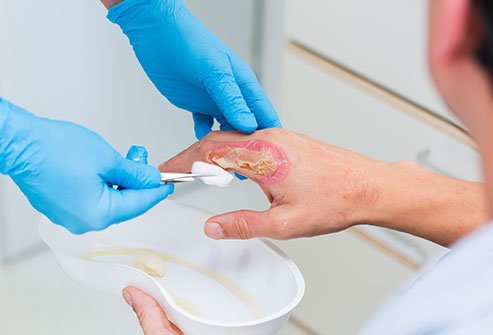Burn: What Are the Four Types of Burns?

A burn is a type of injury caused by any of the below factors:
- Heat (such as hot objects, boiling liquids, steam, fire)
- Chemicals (such as strong acids)
- Electricity
- Sunlight
- Radiation
Burns from hot liquids, steam, and fire are the most common causes of burns.
Depending on how much the burn has penetrated the skin, the burn can be categorized into four types:
- First-degree burns (superficial burns): The damage is restricted only to the outer or topmost layer (epidermis) of the skin.
- Second-degree burns (superficial partial thickness): The damage crosses the epidermis and reaches the layer (dermis) underneath.
- Third-degree burns (deep partial thickness): The deepest layer (hypodermis) of the skin is damaged.
- Fourth-degree burns (full-thickness burns): The skin is destroyed completely with damage to the underlying structures, such as nerves, tendons, and bones.
What do first-, second-, third-, and fourth-degree burns look like?
It may happen that initially a burn appears superficial but becomes deeper over time. If you are unsure how deeply your skin is burned, contact your doctor.
First-degree burns:
- Painful, dry, and red
- Turn white when pressed
- Usually, they heal in 3 to 6 days without scarring
- An example is a non blistering skin burn
Second-degree burns:
- Painful to the extent of being sensitive to even air movement or air temperature
- Red and seep fluid
- Usually form blisters
- Turn white when pressed
- Heal within 7 to 21 days
- Affected skin becomes permanently dark or light in color
- Does not lead to scar formation
- An example is a sunburn that forms blisters after several hours
Third-degree burns:
- Painful with deep pressure
- Almost always form blisters
- Do not turn white with pressure
- Take more than 21 days to heal
- Usually results in severe scarring
- An example is a burn that blisters immediately
Fourth-degree burns:
- Usually painless (due to destruction of the nerve endings)
- Waxy white to leathery gray or charred black color
- Affected skin looks dry
- Does not turn white when touched
- Cannot heal without surgical treatment
- Usually result in severe scarring
How do I heal a burn quickly?
The speed at which a burn heals depends on the cause of the burn and how extensive and deep the burn is.
Antibiotic creams can prevent or treat infections due to burns. Serious burns need regular cleaning of the wound, replacing the skin (skin grafting), and a rich supply of fluids and nutrition with a few to several days of hospital stay.
General tips for healing a burn quickly include:
- Keep the burn clean and protected with a dressing
- Avoid rubbing or scratching the skin; trim your nails regularly
- Moisturize the burnt skin after the wound heals to prevent scarring (petroleum jelly can be used 2 to 3 times a day)
- Increase your protein intake
- Drink plenty of water
- Wear a hat and long-sleeved tops and apply a sunscreen lotion while in the sun
- Wear loose clothes
- Ask your doctor if you can use antibiotic creams or non-steroidal anti-inflammatory drugs (NSAIDs) to hasten wound healing
What happens if a burn is left untreated?
The most common complications of an untreated burn, depending on its depth, include infections and scarring.
Severe cases of deeper burns that cover an extensive part of the body can lead to dehydration, shock, and even death if left untreated.
